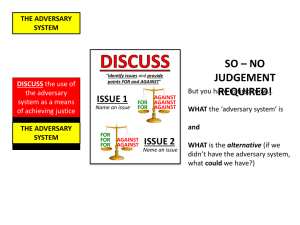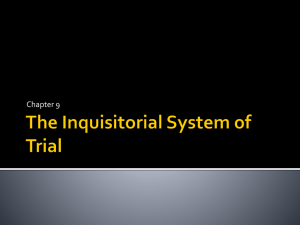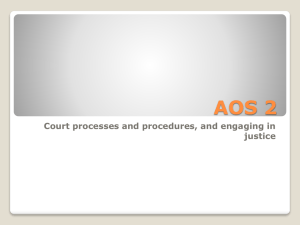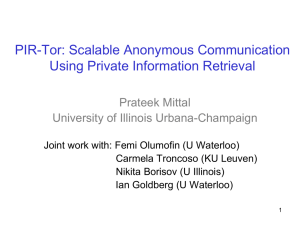ppt - Aaron Michael Johnson
advertisement
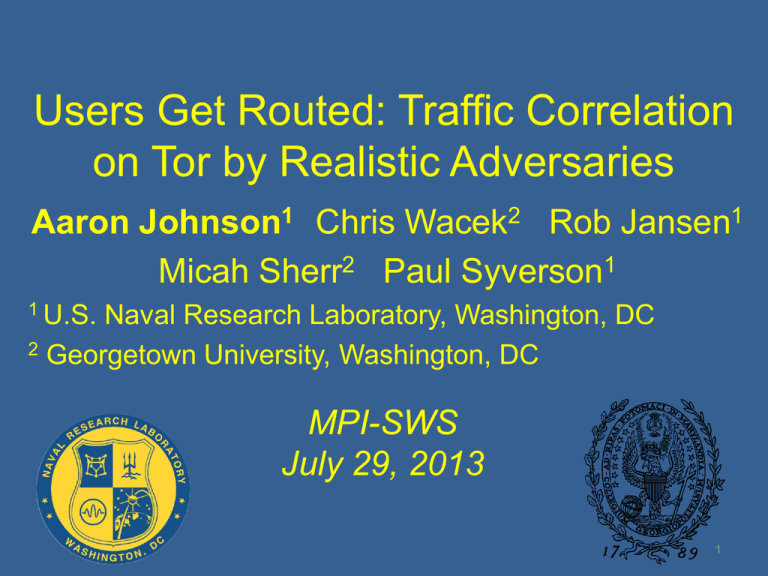
Users Get Routed: Traffic Correlation on Tor by Realistic Adversaries Aaron Johnson1 Chris Wacek2 Rob Jansen1 Micah Sherr2 Paul Syverson1 1 U.S. Naval Research Laboratory, Washington, DC 2 Georgetown University, Washington, DC MPI-SWS July 29, 2013 1 Summary: What is Tor? 2 Summary: What is Tor? Tor is a system for anonymous communication. 3 Summary: What is Tor? Tor is a system for anonymous communication. ^ popular Over 500000 daily users and 2.4GiB/s aggregate 4 Summary: Who uses Tor? 5 Summary: Who uses Tor? • Individuals avoiding censorship • Individuals avoiding surveillance • Journalists protecting themselves or sources • Law enforcement during investigations • Intelligence analysts for gathering data 6 Summary: Tor’s Big Problem 7 Summary: Tor’s Big Problem 8 Summary: Tor’s Big Problem 9 Summary: Tor’s Big Problem 10 Summary: Tor’s Big Problem Traffic Correlation Attack 11 Summary: Tor’s Big Problem Traffic Correlation Attack • Congestion attacks • Throughput attacks • Latency leaks • Website fingerprinting • Application-layer leaks • Denial-of-Service attacks 12 Summary: Our Contributions 13 Summary: Our Contributions 1. Empirical analysis of traffic correlation threat 2. Develop adversary framework and security metrics 3. Develop analysis methodology and tools 14 Overview • Summary • Tor Background • Tor Security Analysis o Adversary Framework o Security Metrics o Evaluation Methodology o Node Adversary Analysis o Link Adversary Analysis • Future Work 15 Overview • Summary • Tor Background • Tor Security Analysis o Adversary Framework o Security Metrics o Evaluation Methodology o Node Adversary Analysis o Link Adversary Analysis • Future Work 16 Background: Onion Routing Users Onion Routers Destinations 17 Background: Onion Routing Users Onion Routers Destinations 18 Background: Onion Routing Users Onion Routers Destinations 19 Background: Onion Routing Users Onion Routers Destinations 20 Background: Onion Routing Users Onion Routers Destinations 21 Background: Using Circuits 22 Background: Using Circuits 1. Clients begin all circuits with a selected guard. 23 Background: Using Circuits 1. Clients begin all circuits with a selected guard. 2. Relays define individual exit policies. 24 Background: Using Circuits 1. Clients begin all circuits with a selected guard. 2. Relays define individual exit policies. 3. Clients multiplex streams over a circuit. 25 Background: Using Circuits 1. 2. 3. 4. Clients begin all circuits with a selected guard. Relays define individual exit policies. Clients multiplex streams over a circuit. New circuits replace existing ones periodically. 26 Overview • Summary • Tor Background • Tor Security Analysis o Adversary Framework o Security Metrics o Evaluation Methodology o Node Adversary Analysis o Link Adversary Analysis • Future Work 27 Adversary Framework 28 Adversary Framework 29 Adversary Framework 30 Adversary Framework 31 Adversary Framework Resource Types • Relays • Bandwidth • Autonomous Systems (ASes) • Internet Exchange Points (IXPs) • Money 32 Adversary Framework Resource Types • Relays • Bandwidth • Autonomous Systems (ASes) • Internet Exchange Points (IXPs) • Money Resource Endowment • Destination host • 5% Tor bandwidth • Source AS • Equinix IXPs 33 Adversary Framework Resource Types • Relays • Bandwidth • Autonomous Systems (ASes) • Internet Exchange Points (IXPs) • Money Resource Endowment • Destination host • 5% Tor bandwidth • Source AS • Equinix IXPs Goal • Target a given user’s communication • Compromise as much traffic as possible • Learn who uses Tor • Learn what Tor is used for 34 Overview • Summary • Tor Background • Tor Security Analysis o Adversary Framework o Security Metrics o Evaluation Methodology o Node Adversary Analysis o Link Adversary Analysis • Future Work 35 Security Metrics Prior metrics Security Metrics Prior metrics 1. Probability of choosing bad guard and exit a. c2 / n2 : Adversary controls c of n relays b. ge : g guard and e exit BW fractions are bad Security Metrics Prior metrics 1. Probability of choosing bad guard and exit a. c2 / n2 : Adversary controls c of n relays b. ge : g guard and e exit BW fractions are bad 2. Probability some AS/IXP exists on both entry and exit paths (i.e. path independence) Security Metrics Prior metrics 1. Probability of choosing bad guard and exit a. c2 / n2 : Adversary controls c of n relays b. ge : g guard and e exit BW fractions are bad 2. Probability some AS/IXP exists on both entry and exit paths (i.e. path independence) 3. gt : Probability of choosing malicious guard within time t Security Metrics Principles 1. Probability distribution 2. Measure on human timescales 3. Based on adversaries 40 Security Metrics Principles 1. Probability distribution 2. Measure on human timescales 3. Based on adversaries Metrics 1. Probability distribution of time until first path compromise 2. Probability distribution of number of path compromises for a given user over given time period 41 Overview • Background • Onion Routing Security Analysis o Problem: Traffic correlation o Adversary Model o Security Metrics o Evaluation Methodology o Node Adversary Analysis o Link Adversary Analysis • Future Work 42 TorPS: The Tor Path Simulator Network Model Relay statuses Streams User Model StreamCircuit Client Software mappings Model 43 TorPS: The Tor Path Simulator Network Model Relay statuses Streams User Model StreamCircuit Client Software mappings Model 44 TorPS: User Model Gmail/GChat Gcal/GDocs Facebook Web search IRC BitTorrent 20-minute traces 45 TorPS: User Model Gmail/GChat Gcal/GDocs Typical Facebook Web search IRC BitTorrent 20-minute traces 46 TorPS: User Model Session schedule Gmail/GChat Gcal/GDocs Typical Facebook One session at 9:00, 12:00, 15:00, and 18:00 Su-Sa Web search IRC Repeated sessions 8:00-17:00, M-F BitTorrent Repeated sessions 0:00-6:00, Sa-Su 20-minute traces 47 TorPS: User Model Session schedule Gmail/GChat Gcal/GDocs Facebook Web search IRC BitTorrent 20-minute traces One session at 9:00, 12:00, 15:00, and 18:00 Su-Sa Typical Worst Port (6523) Best Port Repeated sessions (443) 8:00-17:00, M-F Repeated sessions 0:00-6:00, Sa-Su 48 TorPS: User Model Rank Port # Exit BW % LongLived Application 1 8300 19.8 Yes iTunes? 2 6523 20.1 Yes Gobby 3 26 25.3 No (SMTP+1) 65312 993 89.8 No IMAP SSL 65313 80 90.1 No HTTP 65314 443 93.0 No HTTPS Default-accept ports by exit capacity. 49 TorPS: User Model Typical IRC Streams/wee IPs k 2632 205 135 1 BitTorrent WorstPort BestPorst 6768 2632 2632 Model 171 205 205 Ports (#s) 2 (80, 443) 1 (6697) 118 1 (6523) 1 (443) User model stream activity 50 TorPS: The Tor Path Simulator Network Model Relay statuses Streams User Model StreamCircuit Client Software mappings Model 51 TorPS: The Tor Path Simulator Network Model metrics.torproject.org Hourly consensuses Monthly server descriptors archive 52 TorPS: The Tor Path Simulator Network Model Relay statuses Streams User Model StreamCircuit Client Software mappings Model 53 TorPS: The Tor Path Simulator Client Software Model • Reimplemented path selection in Python • Based on current Tor stable version (0.2.3.25) • Major path selection features include – – – – – Bandwidth weighting Exit policies Guards and guard rotation Hibernation /16 and family conflicts • Omits effects of network performance 54 Overview • Background • Onion Routing Security Analysis o Problem: Traffic correlation o Adversary Model o Security Metrics o Evaluation Methodology o Node Adversary Analysis o Link Adversary Analysis • Future Work 55 Node Adversary 100 MiB/s total bandwidth Relay Type Any Number 2646 Bandwidth (GiB/s) Rank Bandwidth Family (MiB/s) 1 260.5 torservers.net 115.7 Chaos Computer Club 3.10 Guard only 670 1.25 2 Exit only 403 0.30 3 107.8 DFRI Guard & Exit 272 0.98 4 95.3 Team Cymru 5 80.5 Paint Tor relay capacity, 3/31/13 Top Tor families, 3/31/13 56 Node Adversary 100 MiB/s total bandwidth 57 Probability to compromise at least one stream and rate of compromise, 10/12 – 3/13. Node Adversary 100 MiB/s total bandwidth 83.3 MiB/s guard,16.7 MiB/s exit 58 Node Adversary Results Time to first compromised stream, 10/12 – 3/13 Fraction compromised streams, 10/12 – 3/13 59 Node Adversary Results Time to first compromised guard, 10/12 – 3/13 Fraction streams with compromised guard, 10/12 – 3/13 60 Node Adversary Results Time to first compromised exit, 10/12 – 3/13 Fraction compromised exits, 10/12 – 3/13 61 Node Adversary Results Time to first compromised circuit, 10/12-3/13 62 Overview • Background • Onion Routing Security Analysis o Problem: Traffic correlation o Adversary Model o Security Metrics o Evaluation Methodology o Node Adversary Analysis o Link Adversary Analysis • Future Work 63 Link Adversary 64 Link Adversary AS8 AS 6 AS1 AS2 AS 7 AS 6 AS3 AS4 AS5 1. Autonomous Systems (ASes) 65 Link Adversary AS8 AS 6 AS1 AS2 AS 7 AS 6 AS3 AS4 AS5 1. Autonomous Systems (ASes) 2. Internet Exchange Points (IXPs) 66 Link Adversary AS8 AS 6 AS1 AS2 AS 7 AS 6 AS3 AS4 AS5 1. Autonomous Systems (ASes) 2. Internet Exchange Points (IXPs) 3. Adversary has fixed location 67 Link Adversary AS8 AS 6 AS1 AS2 AS 7 AS 6 AS3 AS4 AS5 1. Autonomous Systems (ASes) 2. Internet Exchange Points (IXPs) 3. Adversary has fixed location 68 Link Adversary AS8 AS 6 AS1 1. 2. 3. 4. AS2 AS 7 AS 6 AS3 AS4 AS5 Autonomous Systems (ASes) Internet Exchange Points (IXPs) Adversary has fixed location Adversary may control multiple entities a. “Top” ASes b. IXP organizations 69 Link Adversary Client locations • Top 5 non-Chinese source ASes in Tor (Edman&Syverson 09) AS# Description Country 3320 Deutsche Telekom AG Germany 3209 Arcor Germany 3269 Telecom Italia Italy 13184 HanseNet Telekommunikation 6805 AS/IXP Locations • Ranked for client location by frequency on entry or exit paths • Exclude src/dst ASes • Top k ASes /top IXP organization Germany Telefonica Deutschland Germany Type ID Description AS 3356 Level 3 Communications AS 1299 TeliaNet Global AS 6939 Hurricane Electric IXP 286 DE-CIX Frankfurt IXP Org. DE-CIX DE-CIX Example: Adversary locations for BitTorrent client in AS 3320 70 Link Adversary IXP organizations obtained by manual clustering based on PeerDB and PCH. # IXP Organization Size Country 1 Equinix 26 global 2 PTTMetro 8 Brazil 3 PIPE 6 Australia 4 NIXI 6 India 5 XChangePoint 5 global 6 MAE/VERIZON 5 global 7 Netnod 5 Sweden 8 Any2 4 US 9 PIX 4 Canada 10 JPNAP 3 Japan 11 DE-CIX 2 Germany 12 AEPROVI 2 Equador 13 Vietnam 2 Vietnam 14 NorthWestIX 2 Montana, US 15 Terremark 2 global 16 Telx 2 US 17 NorrNod 2 Sweden 18 ECIX 2 Germany 19 JPIX 2 Japan IXP organizations ranked by size 71 Link Adversary Adversary controls one AS, Time to first compromised stream, 1/13 – 3/13 “Best”: most secure client AS “Worst”: least secure client AS Adversary controls one AS, Fraction compromised streams, 1/13 – 3/13 “Best”: most secure client AS “Worst”: least secure client AS 72 Link Adversary Adversary controls IXP organization, Time to first compromised stream, 1/13 – 3/13, “Best”: most secure client AS “Worst”: least secure client AS Adversary controls top ASes, Time to first compromised stream, 1/13 – 3/13, Only “best” client AS 73 Overview • Background • Onion Routing Security Analysis o Problem: Traffic correlation o Adversary Model o Security Metrics o Evaluation Methodology o Node Adversary Analysis o Link Adversary Analysis • Future Work 74 Future Work 1. Extending analysis 2. Improving guard selection 3. Using trust-based path selection to protect against traffic correlation 4. Dealing with incomplete and inaccurate AS and IXP maps 5. Include Tor’s performance-based pathselection features in TorPS 75

